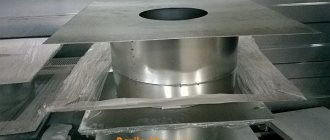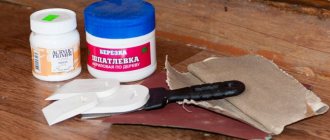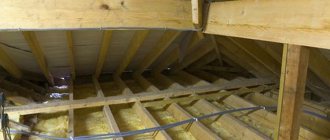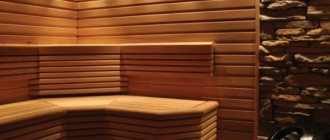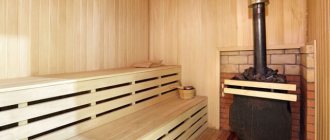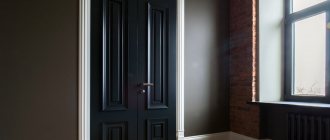After purchasing a stove, some of our clients make a firm decision to install it themselves. We support such initiatives and, whenever possible, help with consultations, because if a person has the time and desire to do something with his own hands, that’s always wonderful. We treat cases with less confidence when clients entrust the installation of a furnace to cheap builders and installers...
The critical difference between these two cases is that the owner will always double-check several times in Yandex: “how to properly install a stove for a bath.” But one-time specialists more often rely on their logic than on SNiP standards - after all, studying the standards is not included in the cost of their work. In this article we will tell you exactly what needs to be checked and taken into account if the installation of the furnace is carried out independently or through dubious specialists.
Why did we decide to write this article? The fact is that about 3 years ago, the government of our country decided that installers of stoves and fireplaces are no longer required to license their activities (Resolution No. 1219 of October 6, 2017).
This means that it’s enough to make a website, fill it with water about your mega-experience, set the price 2-3 times lower than competitors and order advertising. As a result, clients, tempted by the low price, hire such unfortunate masters, after which they find themselves in extremely bad situations. Moreover, the easiest of them is the need to purchase a new stove. But there are worse consequences. You can learn about such “worse” from fire department reports: “The installation was carried out in violation of the standards...”
We recommend not to chase the lowest cost in this matter and either trust professionals, or delve into it and figure it out yourself. It was for the second client case that we decided to prepare a series of articles. This is how this article appeared.
The first piece of advice from our experts is:
If you want to save money on installing a stove for your bathhouse, then understand the basics and supervise the work of hired workers.
If you don’t want to control it, then delve into the issue entirely and install the stove yourself.
If you don’t want to get involved, then leave the issue to a specialized company.
So, you have already built a sauna with a steam room, chosen and bought a stove, and even stocked up on oak brooms. It’s just a matter of little things, well, almost - all that remains is to install the stove and you can enjoy the healing properties of a real Russian wood-fired bathhouse. But to prevent your long-awaited dream from turning into a nightmare, consider the following...
What to install a sauna stove on
A sauna stove, like no other, requires installation on a non-flammable base, because its combustion center is practically on the floor. This means that the temperature load on the floor is greater. We recommend that you use only one of the four base options listed below for sauna stoves.
A metal sheet
Most often, stainless steel or galvanized sheets are used, but painted flood sheets look more beautiful. They come in different sizes, shapes and colors. The options are presented here.
Thermal insulation must be laid under the metal sheet, because... it conducts heat very well. Ordinary basalt cardboard will do, but it is better to additionally use a fiber cement board: faspan, mineralite or flamma.
Agglomerate tiles
This is a tile made from pressed granite chips. Due to the dense structure, the weight of one tile measures 600x600 mm. is 20 kg. As a rule, several pieces are used for the agglomerate base, which are laid on a sheet of CBPB or the same fiber cement board. It is also necessary to use basalt cardboard.
Fig. 1. Base for a sauna stove made of agglomerate tiles
Installation on ordinary porcelain tiles is allowed - the base design will be the same as with agglomerate tiles. But porcelain stoneware is thinner and more fragile, it can burst under the weight of the stove, especially with stones.
Bricks
Installing a sauna stove on bricks is only possible on a flat floor. If a sheet of metal and agglomerate tiles allow for slight unevenness, then the bricks will not “forgive” them - they will move higher and lower. In this case, you will need to level the floor first. If the bricks are laid on a concrete floor, then no thermal protection is required, but if on a wooden floor, then the above-mentioned basalt cardboard can be used.
Fig 2. Grill'D Cometa 180 Vega sauna stove mounted on bricks
Ready bases
Some manufacturers of sauna stoves produce special podiums on which they recommend installing their products. Such podiums, as a rule, do not require additional thermal protection, because have convection channels that cool the floor underneath.
But we consider it not unnecessary to use additional thermal protection under ready-made substrates.
Thermal insulation materials are presented in our section of the website here.
Fig 3. Vesuvius Legend sauna stove installed on the “original” metal base
What types of nodes are there?
In order to protect the ceiling from overheating and fire as much as possible, a cutting or other angle, which can have a different appearance, is used to pass the chimney pipe through the ceiling.
The best option is a ready-made purchased product, which is most often used for industrial work. This option is represented by a metal box equipped with a galvanized plate fixed on one side. In the center, the product is equipped with a continuous opening into which pipes passing through the ceiling are inserted. The product also allows you to lay a thermal insulation layer, and on the room side the box has a decorative plate.
A steel plate is installed around the pipe, which protects the ceiling material from fire or melting
A diagram that allows you to do the ceiling cutting for the chimney yourself
Interesting to know: professional stove makers insist on using a box made of stainless steel as a cutting unit, since the galvanized plate begins to melt a little when heated, as a result of which it begins to release a small amount of substances harmful to health.
In order to install this unit yourself, a hole of suitable shape and size is cut out in the ceiling. Next, the thermal insulation material (minerite, stone wool, asbestos) is fixed. Don't forget to reinforce the structure with metal strips. Self-tapping screws are used to secure the unit. In order to carry out the installation, a special element is put on a straight section of the pipe, after which the structure is raised to the required height and secured on all sides with thermal insulation.
Interesting to know: the appearance and design features of the unit or cutting may vary. It can be either a classic square design or rectangular, round, cylindrical or oval. The heat insulator itself is necessary to provide maximum protection to the ceiling.
If the cutting does not have a cylinder in its design, then it is additionally equipped with special sides, which are based on mineralite or metal.
Safe distance from the stove to the flammable wall
A stove is, first of all, a fire, which means there are regulated standards for its installation and operation for fire safety.
The current rules (SNiP dated April 2, 05-91) state the following: The safe distance from the stove to the flammable wall (including wooden shelves) must be at least 500 mm.*
*Appendix 16 (mandatory). Dimensions of grooves and offsets for stoves and smoke ducts.
How to reduce the distance from the stove to the wooden wall and comply with safety standards?
In practice, the distance is 500 mm. You can't always stand it. You will not rebuild the bathhouse. Fortunately, progress is moving forward every day, and modern thermal insulation materials are appearing on the market, which provide much greater protection than those provided for in SNiP itself. Using such materials, the distance can be reduced to 250 mm. We will talk about them below.
How to check the standards in an accessible way?
To make sure that you have maintained a fire-safe distance, test the wall with your hand. If installed correctly, the wall should be warm at the level of the stove.
Of course, the question of the safe distance from the stove to the flammable wall may be a little late if, during the construction of your bathhouse, you did not particularly compare the dimensions of the future stove with the area allocated for it. And if you still made a slight mistake in this matter, now it will be difficult to cram in what you can’t fit in. In any case, we do not recommend compromising your conscience. Call us and we will advise you on what can be done in your specific situation.
Video on how NOT to install a sauna stove
Please note that incorrect installation consists not only of errors in the distance from the furnace to nearby objects, but also of errors in the installation of electrical wiring, its operation, incorrect arrangement of chimney passages through the ceiling, etc. - all this can cause a future fire, but we will talk about this in the following articles.
Operating a stove in a brick wall
Is the operation of a stove in a brick wall different from a conventional one, which is installed in residential buildings together with a gas heating system? Firstly, switching the fuel type physically cannot occur here. Secondly, the heating must be distributed over the entire wall to prevent burning of the brick in the rough (this can even cause a fire). Thirdly, the combustion chambers that are installed in such stoves have a shallower depth, but a larger width for convenient stacking of firewood. Those that are placed in the bathhouse have a greater height. The reason is similar, that is, for the convenience of stacking firewood and other solid fuels.
Installation
If the house is gasified, as a rule, a pipe branch is made for the stove and other devices.
Most homes have additional ventilation ducts in the kitchen. If there are no devices connected to them, for example, a hood, you can completely connect a fireplace.
Fireplace in the kitchen
It is important to understand that any operations that involve a centralized gas supply are carried out either in the presence of employees of the city (district) gas service or by themselves. It is imperative that when calling specialists from other organizations, it is necessary to notify the gas service about the upcoming work
Only with authorized installation can you be sure of safety.
Insulation of walls and floors around the fireplace
To insulate the walls, multilayer insulating materials are used (basalt wool with a reflective screen, sheets of non-flammable synthetic material), brick.
Properly performed thermal insulation is the key to safety and is carried out using materials such as mineral wool, polystyrene foam, tape tow and others
Before you begin installing the slabs, you need to mark the area around the fireplace within a radius of 75 cm. This is where the multilayer insulation sheets will be attached to a metal profile.
Fire-resistant plasterboard sheets are mounted on top of this layer. The cracks can be sealed with foil. Then reinforcing mesh, putty and painting.
Or the walls near the fireplace can be lined with brick, ceramic tiles, stone, if such a solution fits organically into the design of the room
The flooring around the fireplace must be treated with a facing material that can withstand high temperatures.
The space around the fireplace at a distance of 1.5 meters should be covered with cladding. What are marble, granite and ceramic tiles used for?
Lining the floor near the fireplace protects it from high temperatures, thereby preventing various types of damage
During operation, the fireplace requires constant care, since where there is fire, there is always a risk. It is important to periodically clean the fireplace chimney from accumulation of soot and deposits.
In addition, you need to take care of the appearance of the fireplace and wipe dust from its surface.
Fireplace insert
When building a firebox, it is very important to ensure that it is perfectly horizontal.
The firebox for open fireplaces is placed using refractory bricks, and for closed ones - from metal. The firebox for open fireplaces is placed using refractory bricks, and for closed ones - from metal.
For metal fireboxes, a window made of fire-resistant glass is provided. Fireplaces with closed fireboxes are more efficient and convenient to use, and allow you to control the combustion process.
This affects not only the efficiency of the heating structure, but also its safety.
Masonry must be carried out at positive temperatures to ensure the reliability and strength of the structure.
The first row should be perfectly straight. The outcome of the work directly depends on this.
Conclusions and useful video on the topic
Visual video instructions for installing a fireplace:
To ensure that the fireplace causes less trouble in the future, it must be installed correctly. It is important to take into account fire safety standards and requirements. In addition, each stage of fireplace installation must be designed based on mathematical measurements and calculations. Only compliance with the instructions and all installation rules will ensure safe and comfortable operation.
Still have questions about the stages of installing a fireplace? Or do you want to talk about your personal experience of building a fireplace in a wooden house? Share your story - the comment box is below. Also here you can ask questions to our experts and other site visitors.
